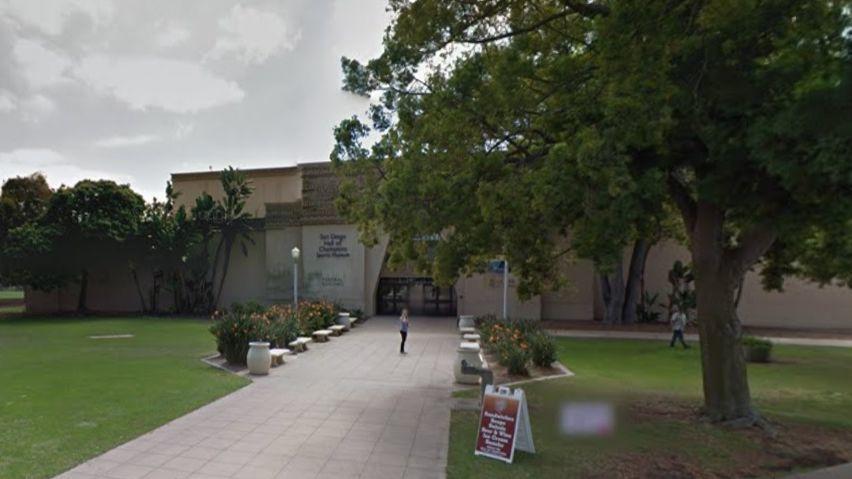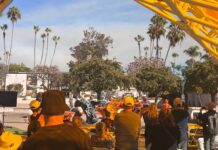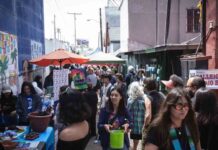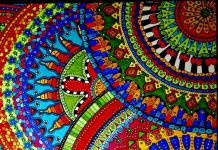1930s baseball bat, 1950s tennis racquet and 1980s skateboard — all totems of San Diego’s rich sporting history — are being swapped out for comics, movie props and souvenirs of today’s pop culture in a major shift at Balboa Park.
The San Diego Hall of Champions, a park institution since 1961, is going out of business and San Diego Comic-Con International is taking its place in a deal blessed by the city Wednesday and announced Thursday.
The sports museum, a creation of the late Bob Breitbard, builder of the San Diego Sports Arena and inveterate sports memorabilia collector, will send its Breitbard Hall of Fame plaques and other local sports legends to Petco Park, return its artifacts to donors and auction what’s not passed along to the San Diego History Center.
Meanwhile Comic-Con, another San Diego-born institution founded in 1970, will expand from just holding conventions to celebrating superheros, blockbuster movies and comic books. The nonprofit group will operate permanent museum to be called the Comic-Con Center for Popular Culture with rotating exhibitions — something convention enthusiasts might see as putting down roots.
“The Hall of Champions has our deepest appreciation in helping us to achieve the new chapter in Comic-Con history,” a Comic-Con spokesman said. “This center will provide a year-round interactive celebration of the innumerable aspects of popular art.”
The new museum would likely open no earlier than 2018, since the sports museum has nine months to vacate the building, north of the Air & Space Museum.
«Balboa Park is the perfect home for this new Comic-Con center to honor the popular arts,» Mayor Kevin Faulconer said in a statement. «As we continue to work on retaining Comic-Con in San Diego, this will be a great permanent fixture for San Diegans and visitors alike to celebrate pop culture all year long.»
According to the lease agreement, the new museum “will be a place to learn about and interact with comics and related popular art forms on a year-round basis.”
“(The museum) will not be a collection institution,” the agreement says. “Exhibits will pull from collectors, museums, galleries and other sources, and will refresh on a regular basis to provide a dynamic visitor experience.”
The agreement was signed by Cybele Thompson, director of the city’s Real Estate Assets Department, and John Rogers, president of Comic-Con. The city charges no rent for use of the building, which was originally built as the Federal Building for the California Pacific International Exposition 1935-36 and rebuilt for the Hall of Champions in 1999.
The sports museum’s Breitbard Hall of Fame, which commemorates decades of local sports heroes, is to move to Petco Park’s Western Metal Building and some of the Hall of Champions’ historical items and all of its photographs and archives will be housed at the San Diego History Center in the park.
“Bob Breitbard was one of San Diego’s greatest sports leaders,” said Padres Executive Chairman Ron Fowler, who also chairs the Hall of Champions board. “The San Diego Hall of Champions is an important community asset and this move positions the organization for a bright, sustainable future. The Padres are glad to welcome the Breitbard Hall of Fame of Petco Park.”
Breitbard, who died at 91 in 2010, coached at Hoover High School and San Diego State College. He founded the Breitbard Athletic Association in 1946 to honor high school athletes, the Breitbard Hall of Fame in 1953 and the Hall of Champions.
He built what was originally called the San Diego Sports Arena in 1966 (now the Valley View Casino Center), where the original San Diego Gulls played hockey and the San Diego Rockets played basketball. Breitbard owned both teams.
Dan Shea, a Hall of Champions board member, said the museum will close down in several months and items on loan, such as from the Padres and Chargers, will be returned to their owners. Cherished items include Ted Williams’ bat, Maureen Connolly’s wooden tennis racquet and Tony Hawk’s skateboard.
Others items and archives not turned over to the history center, located in the Casa de Balboa, will be auctioned off. The museum has nine months to vacate the building. Comic-Con officially became the leaseholder on Wednesday after months of negotiations with the city.
Bill Lawrence, the history center’s executive director, said he is working with the Hall of Champions to identify objects and artifacts that could become part of the center’s permanent exhibition on San Diego’s history.
“The sports aspects of our region are very, very important in that story,” Lawrence said.
The closing down of the 68,000-square-foot museum and transfer to Comic-Con is not unexpected. Such a possibility was announced last year.
Shea said the sports museum with a skeletal staff of six could not carry on, even with income from renting out the facility for special events.
“It’s the changing world of museums and how people use them,” Shea said. “It just got to the point where long-term it was understood it was not going to drive the (visitor) traffic that would make it sustainable.”
The most recent tax return in 2015 from the Hall of Champions indicated expenses of more than $1.5 million and income of $986,810. Admissions brought in $48,509.
Attendance totaled about 16,000 last year. When the new museum was announced in 1994, officials hoped it would draw 400,000 a year.
The museum’s website lists nine exhibition areas on three levels. Besides major league baseball and football, they cover sailing, surfing, other active sports, high school sports and Sports Illustrated covers of San Diego athletes.
Shea said the Hall of Fame’s 153 plaques of San Diego sports legends will be relocated, possibly as early as this summer. The annual awards program and youth and military family activities will continue.
As for Comic-Con, its museum will be a “natural thing” for the pop culture organization to take on, said Jackie Estrada, who runs its annual Will Eisner Comic Industry Awards program.
“Whatever it is, it will just be a treat for whoever comes to Balboa Park,” Estrada said.
However the museum is built out, the announcement indicates that the nonprofit Comic-Con is committing to a long-term presence in San Diego.
The con’s current contract with the San Diego Convention Center expires after next year’s event, and the San Diego Tourism Authority is negotiating to renew it for another three years.
The con annually draws more than 130,000 attendees, the largest of any convention in San Diego, and has spread its meetings and activities beyond the walls of the convention center in recent years.
Comic-Con has endorsed expansion of the convention center but has been repeatedly wooed to move to other cities. It does put on smaller events elsewhere.
Kerri Kapich, chief operating officer of the tourism authority, said the move of the Hall of Fame to Petco and the new Comic-Con museum represent a “real win-win for sports and popular culture.”
“We always thought it would be a really cool idea,” Kapich said of the Comic-Con museum. “They certainly have quite some time to create something that will be incredible and unique. Nobody has anything like this. I’m really excited.
She added, “When you start to let your imagination go a little bit, you could see how it could be truly tremendous. It’s great for Southern California, it’s fantastic for San Diego and I think good for both sports and fans of pop culture.”
Peter Comiskey, executive director of the Balboa Park Cultural Partnership, said the new museum will give tourists, as well as local residents, an additional reason to visit what many consider San Diego’s cultural “crown jewel” with its many museums, gardens and theaters, not to mention the San Diego Zoo.
“I know they will create something for the park that is interesting, engaging and relevant both to our tourist base and residents,” Comiskey said. “They’re a very creative organization and have a fantastic opportunity to use that creatively and positively impact Balboa Park.”
The Hall of Champions’ home in the Federal Building at 2133 Pan American Plaza was built for the California Pacific International Exposition in 1935-36 and served a variety of uses. Plans were mapped out in the 1950s to convert it to a community theater. The Civic Theatre was built in the 1960s next to City Hall downtown instead.
The U.S. Olympic volleyball team had its headquarters in the Federal Building until 1993, when it moved to the U.S. Olympic Training Center in Chula Vista.
The Hall of Champions opened in the House of Charm in 1961 and relocated to the Casa de Balboa in 1983, after its predecessor, the Electric Building, burned down in an arson fire in 1978. The building was rebuilt to also house the San Diego History Center and the San Diego Model Railroad Museum. The Museum of Photographic Arts occupies the Hall of Champion’s earlier space.
The sports museum then spent spent $7.2 million to add a mezzanine and excavate a basement level in the Federal Building.





